| Logistics Support Systems: A new
name for a new future
 The
sustainment market for defense customers is changing and growing rapidly.
According to today's projections, there's about $200 billion in untapped
business for providing the products and services that help customers use
the systems needed to execute their missions. The
sustainment market for defense customers is changing and growing rapidly.
According to today's projections, there's about $200 billion in untapped
business for providing the products and services that help customers use
the systems needed to execute their missions.
Boeing, through its newly named Logistics Support Systems business, is
making key changes to prepare for emerging opportunities. Pat Finneran,
vice president and general manager of Logistics Support Systems, discussed
the changing market and how Boeing is responding.
FULL STORY >>

Getting in sync
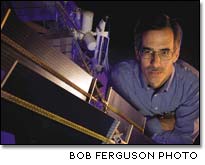 Integrated
Defense Systems is adopting common tools and processes throughout the
organization. These changes all have one main goal—making Boeing
more competitive. IDS Engineering Vice President John Tracy sat down with
Boeing Frontiers to talk about how the change is affecting IDS, IDS Engineering
and IDS engineers. Integrated
Defense Systems is adopting common tools and processes throughout the
organization. These changes all have one main goal—making Boeing
more competitive. IDS Engineering Vice President John Tracy sat down with
Boeing Frontiers to talk about how the change is affecting IDS, IDS Engineering
and IDS engineers.
FULL STORY >>

Room at the top
 Boeing
Integrated Defense Systems is working to build the skills of its program
managers and provide learning opportunities for the next generation of
these key leaders through a new Program Management and Independent Review
function. Boeing
Integrated Defense Systems is working to build the skills of its program
managers and provide learning opportunities for the next generation of
these key leaders through a new Program Management and Independent Review
function.
Howard Chambers, named last September as vice president of IDS Program
Management and Independent Review, recently spent a few minutes with Boeing
Frontiers to discuss the organization's creation, challenges and benefits.
FULL STORY >>

Share the power
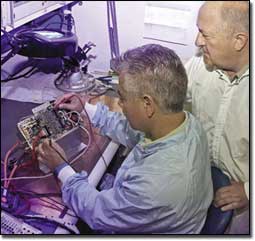 Future
Space Shuttle crews will enjoy extended visits to the International Space
Station thanks to an upgrade that will connect docked shuttles to the
ISS electrical power system. The modification will allow the shuttles
to stay on orbit longer, provide additional time for science and extravehicular
activities, and permit astronauts to unload additional cargo. More work
will get done on each mission. Future
Space Shuttle crews will enjoy extended visits to the International Space
Station thanks to an upgrade that will connect docked shuttles to the
ISS electrical power system. The modification will allow the shuttles
to stay on orbit longer, provide additional time for science and extravehicular
activities, and permit astronauts to unload additional cargo. More work
will get done on each mission.
The Station-Shuttle Power Transfer System (SSPTS) allows the ISS to supplement
the shuttle's electrical power using electricity generated by ISS solar
arrays. This results in a lower consumption of liquid hydrogen and oxygen,
components used by the shuttle's fuel cells for making electricity. The
power transfer system upgrade also will result in a 50 percent increase
in the amount of time the orbiter can dock to the station: from about
seven days to between nine and 12 days, depending on the mission configuration.
FULL STORY >>

Waiting for the green light
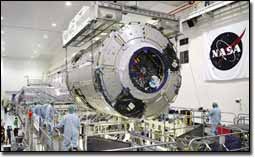 Imagine
you're the proud owner of a new Corvette. Naturally, the first thing you
want to do is take that baby out for a spin. Only problem is, the wheels
are missing. What are you supposed to do with a Corvette with no wheels? Imagine
you're the proud owner of a new Corvette. Naturally, the first thing you
want to do is take that baby out for a spin. Only problem is, the wheels
are missing. What are you supposed to do with a Corvette with no wheels?
That's essentially the same question Boeing's Florida Operations employees
working at the Space Station Processing Facility (SSPF) faced. After the
Space Shuttle program was put on hold after the Space Shuttle Columbia
accident, awaiting the return to flight feels as if someone had taken
the wheels off of their expensive new car.
For almost three years, the SSPF has functioned as a jam-packed garage
for the remaining International Space Station (ISS) elements while waiting
for the Space Shuttle to return to flight.
FULL
STORY>>

Fast work for a big request
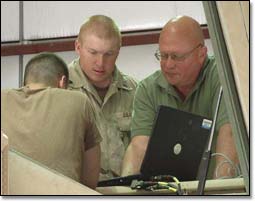 When
Boeing Air & Missile Defense Systems employees asked U.S. air defense
soldiers recently returned from Iraq what could be done to enhance the
capability of Avenger fire units, the Boeing team listened. And then they
took action. When
Boeing Air & Missile Defense Systems employees asked U.S. air defense
soldiers recently returned from Iraq what could be done to enhance the
capability of Avenger fire units, the Boeing team listened. And then they
took action.
In partnership with the U.S. Army, Boeing designed a modification to
its Avenger short-range air defense weapon system that would not only
increase the system's firepower but also make its ground-support capabilities
more relevant in today's urban battlefield. And, the team did it in a
matter of weeks.
FULL STORY >>

Center stage
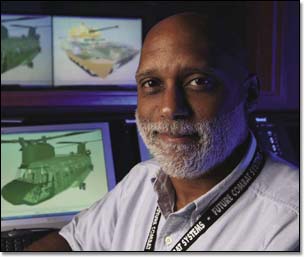 An
unmanned aerial vehicle and AH-64 Apache attack helicopter take off from
the desert near Mesa, Ariz., as a team of Boeing engineers and customers
in St. Louis relays coordinates and participates in a maneuver simulation
in Huntington Beach, Calif. Another team in a proprietary location is
busy observing related hardware and computer systems to ensure the simulated
combat mission is successful. An
unmanned aerial vehicle and AH-64 Apache attack helicopter take off from
the desert near Mesa, Ariz., as a team of Boeing engineers and customers
in St. Louis relays coordinates and participates in a maneuver simulation
in Huntington Beach, Calif. Another team in a proprietary location is
busy observing related hardware and computer systems to ensure the simulated
combat mission is successful.
This scenario isn't just wishful thinking. The recently expanded Modeling,
Simulation and Analysis Center (MSAC) at Boeing Rotorcraft Systems in
Philadelphia is helping to make this vision a reality.
On May 16, Boeing, U.S. Army and local political leaders dedicated the
new $4.5 million MSAC expansion, further augmenting the company's portfolio
of network centric–enabled facilities.
FULL STORY>>

Reaching out
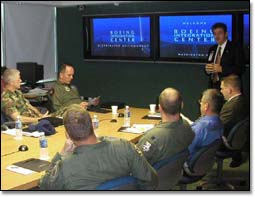 The
Analysis, Modeling and Simulation team solved the problem of being at
multiple places at the same time with the inauguration of the first two
Boeing Integration Center–Distributed Environments (BIC-DEs). Opened
May 24 at the Hampton and Norfolk, Va., Boeing Field Offices, BIC-DEs
are multiscreen portals capable of receiving content originating from
other Boeing modeling and simulation laboratories. The
Analysis, Modeling and Simulation team solved the problem of being at
multiple places at the same time with the inauguration of the first two
Boeing Integration Center–Distributed Environments (BIC-DEs). Opened
May 24 at the Hampton and Norfolk, Va., Boeing Field Offices, BIC-DEs
are multiscreen portals capable of receiving content originating from
other Boeing modeling and simulation laboratories.
Designed to bring the capabilities of the Boeing modeling and simulation
network closer to Integrated Defense Systems' military customers, BIC-DEs
offer a more convenient place for customers to collaborate with Boeing
engineers. Their dispersed locations also better emulate the way customers
actually fight, acting as dissimilar nodes sharing information via mobile,
ad hoc networks.
FULL STORY >>
|

